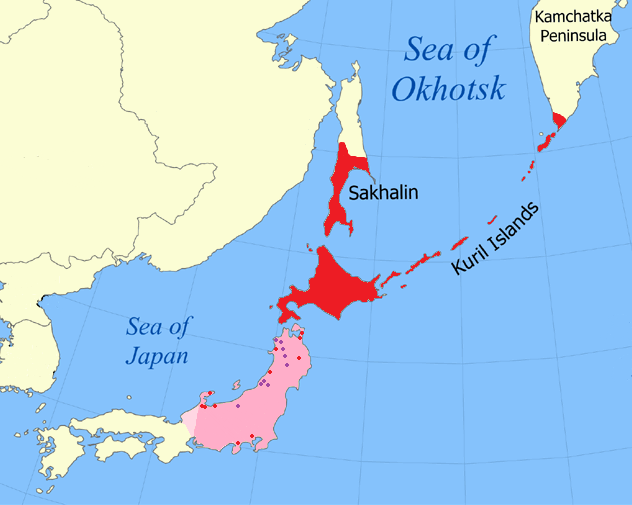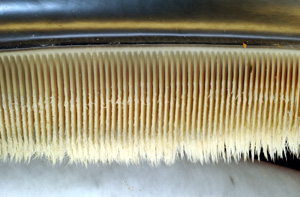|
Cape Levenshtern
Cape Levenshtern (Russian: ''Mys Levenshterna'') is a cape on the northeast coast of Sakhalin Island in the western Sea of Okhotsk. It is rounded and rugged. It lies 37 km (about 23 mi) to the south-southeast of Cape Elizabeth, the northern point of the island.National Geospatial-Intelligence Agency. (2014). ''Sailing Directions (Enroute): East Coast of Russia''. U.S. Government, Springfield, Virginia. History On the night of 7 June 1855, the ship ''Jefferson'' (396 tons), of New London, was wrecked on the cape during a dense fog. All hands were saved by the ship ''Reindeer'', of New Bedford, which also salvaged most of the cargo of oil and bone A bone is a rigid organ that constitutes part of the skeleton in most vertebrate animals. Bones protect the various other organs of the body, produce red and white blood cells, store minerals, provide structure and support for the body, .... References Levenshtern Shipwrecks in the Sea of Okhotsk {{SakhalinOblast-g ... [...More Info...] [...Related Items...] OR: [Wikipedia] [Google] [Baidu] |
Sakhalin Oblast
Sakhalin Oblast ( rus, Сахали́нская о́бласть, r=Sakhalinskaya oblastʹ, p=səxɐˈlʲinskəjə ˈobləsʲtʲ) is a federal subject of Russia (an oblast) comprising the island of Sakhalin and the Kuril Islands in the Russian Far East. The oblast has an area of . Its administrative center and largest city is Yuzhno-Sakhalinsk. As of the 2021 Census, the oblast has a population of 466,609. The vast majority of the oblast's residents are ethnic Russians, with a small minority of Sakhalin Koreans. Sakhalin Oblast is rich in natural gas and oil, and is Russia's second wealthiest federal subject after the Tyumen Oblast. It borders by sea Khabarovsk Krai to the west and Kamchatka Krai to the north, along with Hokkaido, Japan to the south. History The etymology of Sakhalin can be traced back to the Manchu hydronym ''Sahaliyan Ula'' (Manchu: ) for "Black River" (''i.e.'' the Amur River). Sakhalin shares this etymology with the Chinese province of Heilongjiang (C ... [...More Info...] [...Related Items...] OR: [Wikipedia] [Google] [Baidu] |
Russian Language
Russian is an East Slavic languages, East Slavic language belonging to the Balto-Slavic languages, Balto-Slavic branch of the Indo-European languages, Indo-European language family. It is one of the four extant East Slavic languages, and is the native language of the Russians. It was the ''de facto'' and ''de jure'' De facto#National languages, official language of the former Soviet Union.1977 Soviet Constitution, Constitution and Fundamental Law of the Union of Soviet Socialist Republics, 1977: Section II, Chapter 6, Article 36 Russian has remained an official language of the Russia, Russian Federation, Belarus, Kazakhstan, Kyrgyzstan, and Tajikistan, and is still commonly used as a lingua franca in Ukraine, Moldova, the Caucasus, Central Asia, and to a lesser extent in the Baltic states and Russian language in Israel, Israel. Russian has over 253 million total speakers worldwide. It is the List of languages by number of speakers in Europe, most spoken native language in Eur ... [...More Info...] [...Related Items...] OR: [Wikipedia] [Google] [Baidu] |
Sakhalin Island
Sakhalin ( rus, Сахали́н, p=səxɐˈlʲin) is an island in Northeast Asia. Its north coast lies off the southeastern coast of Khabarovsk Krai in Russia, while its southern tip lies north of the Japanese island of Hokkaido. An island of the West Pacific, Sakhalin divides the Sea of Okhotsk to its east from the Sea of Japan to its southwest. It is administered as part of Sakhalin Oblast and is the largest island of Russia, with an area of . The island has a population of roughly 500,000, the majority of whom are Russians. The indigenous peoples of the island are the Ainu, Oroks, and Nivkhs, who are now present in very small numbers. The island's name is derived from the Manchu word ''Sahaliyan'' (), which was the name of the Qing dynasty city of Aigun. The Ainu people of Sakhalin paid tribute to the Yuan, Ming, and Qing dynasties and accepted official appointments from them. Sometimes the relationship was forced but control from dynasties in China was loose ... [...More Info...] [...Related Items...] OR: [Wikipedia] [Google] [Baidu] |
Sea Of Okhotsk
The Sea of Okhotsk; Historically also known as , or as ; ) is a marginal sea of the western Pacific Ocean. It is located between Russia's Kamchatka Peninsula on the east, the Kuril Islands on the southeast, Japan's island of Hokkaido on the south, the island of Sakhalin along the west, and a stretch of eastern Siberian coast along the west and north. Its northeast corner is the Shelikhov Gulf. The sea is named for the port of Okhotsk, itself named for the Okhota River. Geography The Sea of Okhotsk covers an area of , with a mean depth of and a maximum depth of . It is connected to the Sea of Japan on either side of Sakhalin: on the west through the Sakhalin Gulf and the Gulf of Tartary; on the south through the La Pérouse Strait. In winter, navigation on the Sea of Okhotsk is impeded by ice floes. Ice floes form due to the large amount of freshwater from the Amur River, lowering the salinity of upper levels, often raising the freezing point of the sea surface. The ... [...More Info...] [...Related Items...] OR: [Wikipedia] [Google] [Baidu] |
Cape Elizabeth (Sakhalin)
Cape Elizabeth (, "Gaoto-misaki") is a cape on the Schmidt Peninsula. It is the northernmost point of Sakhalin. Cape Elizabeth was named by Adam Johann von Krusenstern (aka ''Ivan Kruzenstern'') in 1805 after Empress Elizaveta, wife of Alexander I of Russia. The cape is a territory under administration of the Okhinsky District and was even considered the northernmost point of Japan until the Treaty of Saint Petersburg in 1875 when it was replaced by the northernmost point of Atlasov Island (known in Japanese as and in Ainu as Oyakoba). History Between 1848 and 1874, American whaleships caught bowhead whales off the cape. They also went ashore to obtain wood.''Navy'', of New Bedford, Sep. 19, 1861, Kendall Whaling Museum. See also *Cape Crillon Cape Crillon (, "Nishinotoro-misaki" (Cape Nishinotoro in Japanese), ) is the southernmost point of Sakhalin. The cape was named by Frenchman Jean-François de La Pérouse, who was the first European to discover it. Cape Sōya, i ... [...More Info...] [...Related Items...] OR: [Wikipedia] [Google] [Baidu] |
New London, Connecticut
New London is a seaport city and a port of entry on the northeast coast of the United States, located at the outlet of the Thames River (Connecticut), Thames River in New London County, Connecticut, which empties into Long Island Sound. The city is part of the Southeastern Connecticut Planning Region, Connecticut, Southeastern Connecticut Planning Region. New London is home to the United States Coast Guard Academy, Connecticut College, Mitchell College, and The Williams School. The Coast Guard Station New London and New London Harbor is home port to both the Coast Guard's Cutter (boat), cutter ''Coho'' and their tall ship USCGC Eagle (WIX-327), ''Eagle''. The city had a population of 27,367 at the 2020 census. The Norwich, Connecticut, Norwich–New London metropolitan area includes 21 towns and 274,055 people. History Colonial era The area was called Nameaug by the Pequot Native Americans of the United States, Indians. John Winthrop, Jr. founded the first English settlemen ... [...More Info...] [...Related Items...] OR: [Wikipedia] [Google] [Baidu] |
New Bedford, Massachusetts
New Bedford is a city in Bristol County, Massachusetts, United States. It is located on the Acushnet River in what is known as the South Coast region. At the 2020 census, New Bedford had a population of 101,079, making it the state's ninth-largest city and the largest of the South Coast region. It is the second-largest city in the Providence-New Bedford, RI-MA Metropolitan Statistical Area, which is also a part of the greater Boston, Massachusetts Combined Statistical Area. Up through the 17th century, the area was the territory of the Wampanoag Indians. English colonists bought the land on which New Bedford would later be built from the Wampanoag in 1652, and the original colonial settlement that would later become the city was founded by English Quakers in the late 17th century. The town of New Bedford itself was officially incorporated in 1787. During the first half of the 19th century, New Bedford was one of the world's most important whaling ports. At its economic hei ... [...More Info...] [...Related Items...] OR: [Wikipedia] [Google] [Baidu] |
Whale Oil
Whale oil is oil obtained from the blubber of whales. Oil from the bowhead whale was sometimes known as train-oil, which comes from the Dutch word ''traan'' ("tear drop"). Sperm oil, a special kind of oil used in the cavities of sperm whales, differs chemically from ordinary whale oil: it is composed mostly of liquid wax. Its properties and applications differ from those of detergentized whale oil, and it was sold for a higher price. Source and use Emerging industrial societies used whale oil in oil lamps and to Soap#History, make soap. In the 20th century it was made into margarine. There is a misconception that commercial development of the petroleum industry and vegetable oils saved whales from extinction. In fact, the development of petroleum accelerated the whaling industry, which peaked in the 1960s. In the 21st century, with most countries having banned whaling, the sale and use of whale oil has practically ceased. Whale oil was obtained by boiling strips of blubber ha ... [...More Info...] [...Related Items...] OR: [Wikipedia] [Google] [Baidu] |
Baleen
Baleen is a filter feeder, filter-feeding system inside the mouths of baleen whales. To use baleen, the whale first opens its mouth underwater to take in water. The whale then pushes the water out, and animals such as krill are filtered by the baleen and remain as a food source for the whale. Baleen is similar to bristles and consists of keratin, the same substance found in human fingernails, skin and hair. Baleen is a skin derivative. Some whales, such as the bowhead whale, have baleen of differing lengths. Other whales, such as the gray whale, only use one side of their baleen. These baleen bristles are arranged in plates across the upper jaw of whales. Depending on the species, a baleen plate can be long, and weigh up to . Its hairy fringes are called baleen hair or whalebone hair. They are also called baleen bristles, which in sei whales are highly calcified, with calcification functioning to increase their stiffness. Baleen plates are broader at the gumline (base). The p ... [...More Info...] [...Related Items...] OR: [Wikipedia] [Google] [Baidu] |
Headlands Of Sakhalin Oblast
A headland, also known as a head, is a coastal landform, a point of land usually high and often with a sheer drop, that extends into a body of water. It is a type of promontory. A headland of considerable size often is called a cape.Whittow, John (1984). ''Dictionary of Physical Geography''. London: Penguin, 1984, pp. 80, 246. . Headlands are characterised by high, breaking waves, rocky shores, intense erosion, and steep sea cliff. Headlands and bays are often found on the same coastline. A bay is flanked by land on three sides, whereas a headland is flanked by water on three sides. Headlands and bays form on discordant coastlines, where bands of rock of alternating resistance run perpendicular to the coast. Bays form when weak (less resistant) rocks (such as sands and clays) are eroded, leaving bands of stronger (more resistant) rocks (such as chalk, limestone, and granite) forming a headland, or peninsula. Through the deposition of sediment within the bay and the erosion of th ... [...More Info...] [...Related Items...] OR: [Wikipedia] [Google] [Baidu] |






